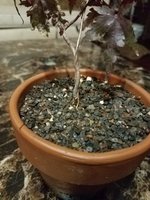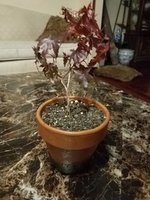"Arakawa' is a cultivar of Japanese maple. It is Acer palmatum. It is not a separate species. Prior to 1970, Japanese horticulture did not follow the same rules as European-American horticulture. In the USA-EU hort, a cultivar name in single quotes refers to a single clone, a single seedling, of a species. For example Acer palmatum 'Bloodgood' refers to a single seedling of Japanese maple. It was propagated by grafting and meristematic tissue culture to produce literally millions of plants, but they are all genetically identical, they came all from a single seed.
Prior to 1970, Japanese horticulture did not follow this naming convention. If a group of seedlings all happened to have the same important traits, they would often get the same name. For example dwarf flowering quince of genus Chaenomeles, there are a group of clones from a region that as they age beyond 25 years, develop corky bark. These cork bark varieties got the name 'Chojubai'. The best small handful were propagated, but this is the reason that there are 'Chojubai' with scarlet orange flowers, there are clones with much redder flowers, there are a few clones that produce cork bark somewhat younger than the others. There is even a white flowered 'Chojubai'. Since 1970 Japan has adopted the EU-USA naming conventions. Now a days you can buy 'Chojubai Red', Chojubai White', and so on.
Seedlings from 'Arakawa' may or may not have the salient feature of 'Arakawa' which is the cork bark, or wart bark. Since it takes 10 to 25 years for this trait to develop, you will not know with seedlings. Modern naming conventions require that any seedling from 'Arakawa' must be given a unique name. It is not legitimate to call a seedling 'Arakawa' as being from seed by definition means the genetics have been resorted. Only asexually propagated cuttings, air layers and grafts from a 'Arakawa' with documented provenance may be legitimately call 'Arakawa'.
Seedlings from 'Arakawa' can be given unique names. and the names can reference the traits it has retained, but it can not be called 'Arakawa'.
That said, The Oregon, USA based breeder of Japanese Maples, Talon Buchholz has a wonderful blog, where he discusses all things maple and conifer for the landscape. (not bonsai) Talon Buchholz raises thousands of japanese maples from seed, and is the originator of quite a number of popular JM, including 'Purple Ghost' and others.

florawonder.blogspot.com
So using Talon Buchholz as a reference, it is very much worth while planting maples from seed, and if you get a good one, propagating it and registering a name for it.








